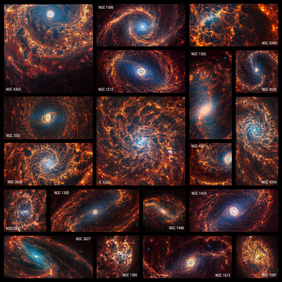The Webb Space Telescope continues to provide images of unprecedented clarity at infrared wavelengths helping to reveal missing pieces of the star formation puzzle. Struck by their beauty and staggering structural wealth NASA decided to release new observations of 19 nearby spiral galaxies. Oleg Egorov from ZAH/ARI is one of the main contributors to the data reduction software which transformed JWST observations into these amazing science data products.
It is hard to think of other objects in the universe that can beat the beauty and mesmerizing structure of spiral galaxies. Due to its capabilities of detecting near- and mid-infrared light especially NASA’s James Webb Space Telescope (JWST) can deliver highly detailed scenes of the distribution of their stars, gas and dust that eventually will reveal missing pieces of the star formation puzzle. Recently, a new set of compelling images of breathtaking structural richness was publicly released.
These Webb images are part of the Physics at High Angular resolution in Nearby GalaxieS (PHANGS) program, a large, long-standing project, which is supported by more than 150 astronomers worldwide. At Heidelberg University's Center for Astronomy (ZAH), Dr. Kathryn Kreckel has served as lead of the PHANGS science working group that studies the connection between gas ionization and star formation.
Dr. Oleg Egorov, postdoctoral researcher in Kreckel's Emmy Noether Research Group, uses PHANGS data to study polycyclic aromatic hydrocarbons (PAHs). These molecules are ubiquitous in the interstellar medium, stand out in the mid-infrared range, and serve as tracer of the local physical and chemical processes. But Oleg Egorov not only uses JWST observations for his research, he together with Thomas Williams from the University of Oxford in the United Kingdom is one of the main developers of a code and data reduction pipeline called PJPipe (the PHANGS-JWST Pipeline) improving the reduction of large mosaics and nearby galaxies with extended diffuse emission. In fact, PJPipe was used to produce the beautiful JWST images in the current image release.
"My main motivation to work on these data was that we had never seen the structure of the interstellar medium of the nearby galaxies beyond the Local Group in so much detail. With the new JWST/MIRI images, we can now investigate how the polycyclic aromatic hydrocarbons (PAH) are distributed across the discs with a resolution that has been never achieved before," enthuses Egorov. The telescope’s Mid-Infrared Instrument (MIRI) highlights glowing dust, showing us where it exists around and between stars. Also Egorov's collaborator Thomas Williams feels like his team lives in a constant state of being overwhelmed – in a positive way – by the amount of detail in these images.
Thanks to the available multiwavelength PHANGS data from other instruments like MUSE installed at the VLT in Chile and spectra obtained by the Hubble Space Telescope (HST) Egorov already learned much about the evolution of PAHs in the Interstellar Medium of galaxies. In particular, he already found that PAH molecules are being destroyed in the HII regions due to the presence of the hydrogen-ionizing radiation and almost independently of the environment.
RELATED PRESS RELEASE
NASA's Webb Depicts Staggering Structure in 19 Nearby Spiral Galaxies
JWST overview and individual images
Heidelberg University Press Release
ABOUT JWST
The James Webb Space Telescope is the world's premier space science observatory. Webb is solving mysteries in our solar system, looking beyond to distant worlds around other stars, and probing the mysterious structures and origins of our universe and our place in it. Webb is an international program led by NASA with its partners, ESA (European Space Agency) and the Canadian Space Agency. For more info see Webb Space Telescope Homepage
ADDITIONAL INFORMATION
PHANGS Collaboration Homepage
European Southern Observatory (ESO)
Center for Astronomy of Heidelberg University (ZAH)
Homepage of Dr. Kathryn Kreckel
Homepage of Dr. Oleg Egorov
LOCAL CONTACT FOR THE MEDIA
Dr. Guido Thimm
Center for Astronomy of Heidelberg University (ZAH)
thimm@uni-heidelberg.de

